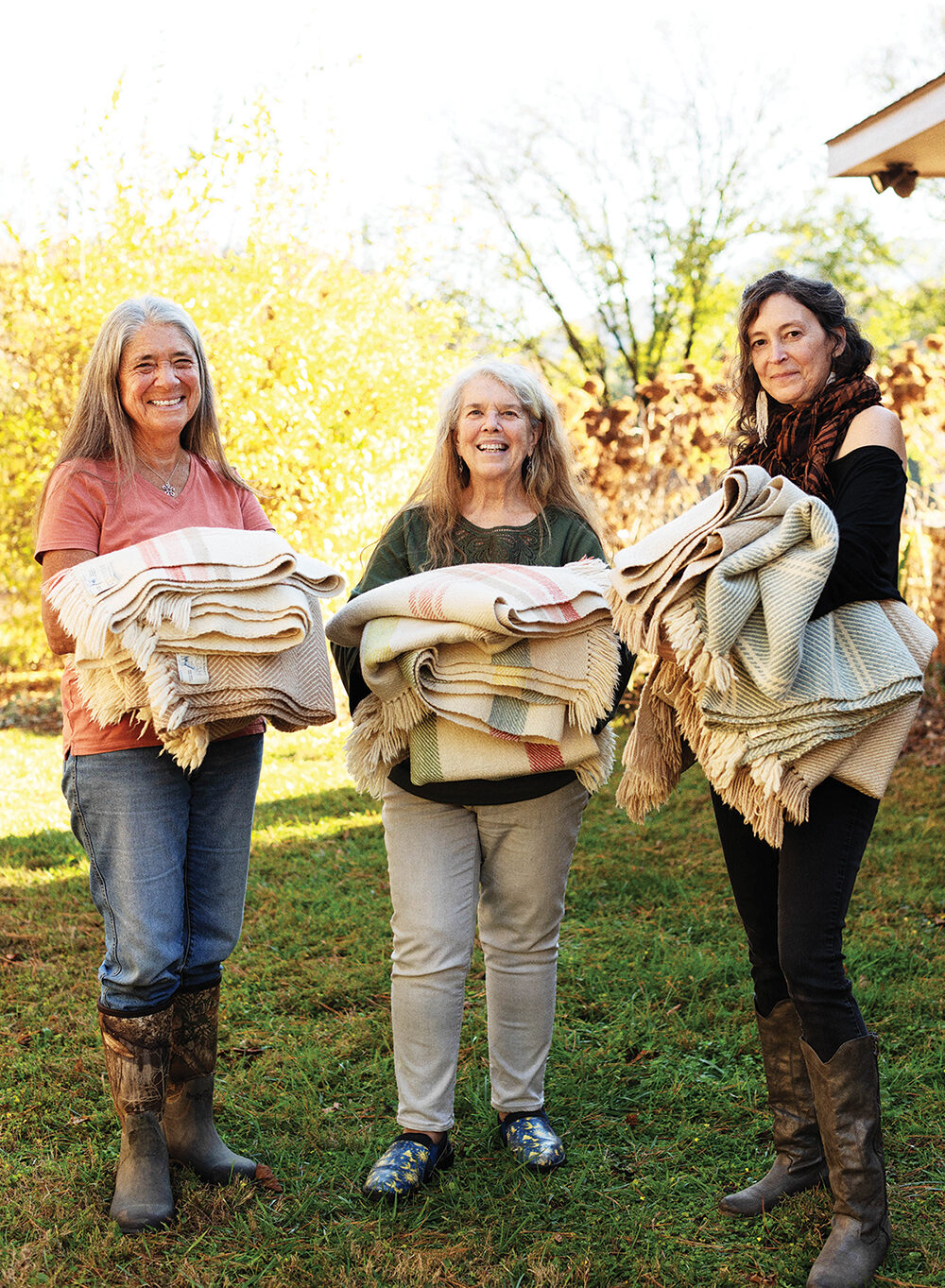Nonprofit restores locally crafted blankets in the wake of Helene

Photo by Colby Rabon
“Shocking and heartbreaking.” That’s how shepherdess Caroline Williford describes the state of Local Cloth, a fiber-art nonprofit located on Depot Street in the River Arts District, when the floodwaters finally receded two days after Hurricane Helene.
“The French Broad River that gives our neighborhood its name rose higher than the Great Flood of 1916, busting out our windows and front door and swelling up to 11 feet inside the studio,” says Williford. She describes the aftermath as an “unrecognizable landscape” of toxic mud.
The wreckage wasn’t contained inside Local Cloth’s four walls, either. A giant loom was found in the adjacent parking lot; a spinning wheel got stuck deep in the sidewalk.
In the coming weeks, staff and volunteers began processing the wreckage, salvaging naturally dyed tunics, needle-felted landscapes, and other one-of-a-kind works of art once displayed proudly on the studio’s walls. Williford was especially concerned about nearly 100 pieces produced through the Blue Ridge Blankets Project, an initiative designed to bring together regional fiber farmers and artists to craft unique coverlets.
“The mission of the Blue Ridge Blankets Project is to revitalize our region’s fiber economy through the ongoing production of locally sourced and crafted blankets,” says Williford, who oversees the effort. “Every blanket we create directly supports our local fiber farmers, dyers, and weavers.”

A row of flood-salvaged blankets dries in the late-autumn sunlight.
Photo by Colby Rabon
According to Local Cloth co-founder Judi Jetson, the project took shape in 2021 when she secured a grant from The Community Foundation of Western North Carolina. Using that seed money, the nonprofit began sourcing fine wool, mohair, and alpaca from more than a dozen farms across the region. The fiber was then washed, carded, spun, and dyed before being woven into blankets by local fiber artists, including students enrolled in Haywood Community College’s Professional Crafts Program and the Fiber Arts Crew at Warren Wilson College.
In 2023, Local Cloth offered a limited run of five designs: the French Broad River, featuring indigo dye with white stripes; the Pisgah, a classic twill dyed with walnut; the Black Mountain, a vibrant multi-colored plaid; the Barnardsville, a simple undyed twill; and the Asheville, which showcases hand-dyed stripes of indigo, madder root, weld, and walnut. This year, weavers began working on a handful of other designs inspired by local towns, mountains, and waterways.
“There’s a ‘wow’ feeling when most people touch and hold these blankets,” says Jetson. “They feel honest and real.
Sadly, dozens of the blankets were either buried under feet of toxic mud or washed away during the flood. But, miraculously, 52 were recovered.
“Among the highest number of blankets found was the French Broad River blanket, the very river that destroyed our studio,” says Williford. “We unearthed a box of 10 of these blankets. Newly woven, labels not yet sewn on. It’s a lovely irony — the river had a hand in preserving her namesake.”
Peggy Eckel, a Local Cloth board member, also had a hand in preserving these heirlooms.
As the only Local Cloth member with running water after the storm, Eckel took the recovered blankets back to her Leicester home and hosed them off. After an initial rinse, she soaked the blankets in a mixture of water and vinegar, tossed them in the washing machine with a powerful scouring soap, and then hung them on a line to dry.
“They turned out amazingly clean and beautiful,” says Eckel. “Most of them have no signs of trauma at all.”

Photo by Colby Rabon
In early November, Local Cloth released the first batch of restored blankets on the organization’s website. The response was “overwhelming,” says Williford.
Going into the holiday season, shoppers can support the Blue Ridge Blankets Project by purchasing one of the few blankets that escaped the hurricane, pre-ordering a new blanket, or buying a blanket that has lovingly been restored in the wake of disaster.
“Restoring blankets directly supports our mission to revitalize the textile economy in our region,” says Williford.“With this hurricane, our fiber farmers, dyers, weavers, designers, and mills have all been impacted. One farmer lost their entire flock [of goats]. We are doubling down to serve our fiber community from this catastrophic point in history. The meaning behind our restored blankets is truly one of resilience.”
Jetson echoes this sentiment, noting that “the farmers and artists here are creative, strong, and stubborn, and will survive this and come back more united than ever.”
Local Cloth, 408 Depot St., Suite 100, River Arts District, Asheville. Blankets produced through the Blue Ridge Blankets Project are available to purchase online at localcloth.org.